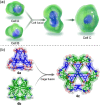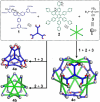Fusion of two homoleptic truncated tetrahedra into a heteroleptic truncated octahedron
- PMID: 39165732
- PMCID: PMC11331344
- DOI: 10.1039/d4sc02736a
Fusion of two homoleptic truncated tetrahedra into a heteroleptic truncated octahedron
Abstract
The exploration of novel structures and structural transformation of supramolecular assemblies is of vital importance for their functions and applications. Herein, based on coordination-driven self-assembly, we prepare a neutral truncated tetrahedron and a heteroleptic truncated octahedron, whose structures are unambiguously confirmed by X-ray diffraction analysis. More importantly, the truncated tetrahedron is quantitatively transformed into the truncated octahedron through its fusion with another cationic truncated tetrahedron, as evidenced by fluorescence, mass and NMR spectroscopy. This study not only deepens our understanding of the process of supramolecular fusion but also opens up possibilities for the subsequent preparation of advanced supramolecular assemblies with complex structures and integrated functions.
This journal is © The Royal Society of Chemistry.
Conflict of interest statement
The authors declare no competing financial interests.
Figures






Similar articles
-
Integrative Assembly of Heteroleptic Tetrahedra Controlled by Backbone Steric Bulk.J Am Chem Soc. 2021 May 5;143(17):6339-6344. doi: 10.1021/jacs.1c01931. Epub 2021 Apr 26. J Am Chem Soc. 2021. PMID: 33900773 Free PMC article.
-
Coordination-driven self-assembly of truncated tetrahedra capable of encapsulating 1,3,5-triphenylbenzene.Inorg Chem. 2010 Nov 15;49(22):10238-40. doi: 10.1021/ic1018373. Epub 2010 Oct 15. Inorg Chem. 2010. PMID: 20949905 Free PMC article.
-
Supramolecular Coordination Cages Based on N-Heterocyclic Carbene-Gold(I) Ligands and Their Precursors: Self-Assembly, Structural Transformation and Guest-Binding Properties.Chemistry. 2021 May 20;27(29):7853-7861. doi: 10.1002/chem.202100710. Epub 2021 Apr 22. Chemistry. 2021. PMID: 33780062
-
Palladium(II)-Based Self-Assembled Heteroleptic Coordination Architectures: A Growing Family.Chemistry. 2019 Sep 20;25(53):12241-12269. doi: 10.1002/chem.201900831. Epub 2019 Jul 12. Chemistry. 2019. PMID: 31158303 Review.
-
[Supramolecular chemistry of multinuclear zinc(II) complexes in aqueous solution].Yakugaku Zasshi. 2002 Dec;122(12):1095-108. doi: 10.1248/yakushi.122.1095. Yakugaku Zasshi. 2002. PMID: 12510387 Review. Japanese.
References
-
- Vittal J. J. Coord. Chem. Rev. 2007;251:1781–1795. doi: 10.1016/j.ccr.2007.02.002. - DOI
LinkOut - more resources
Full Text Sources

